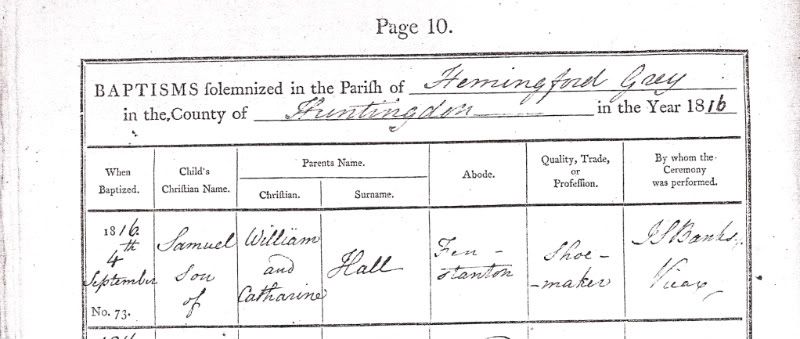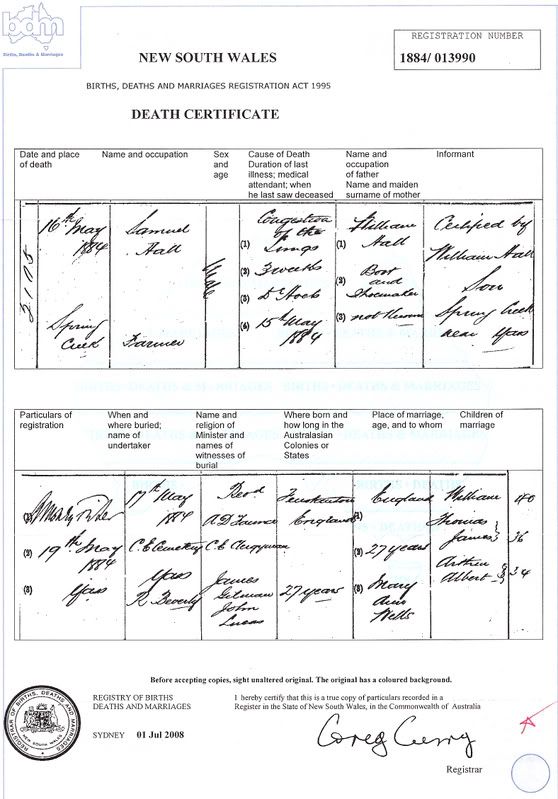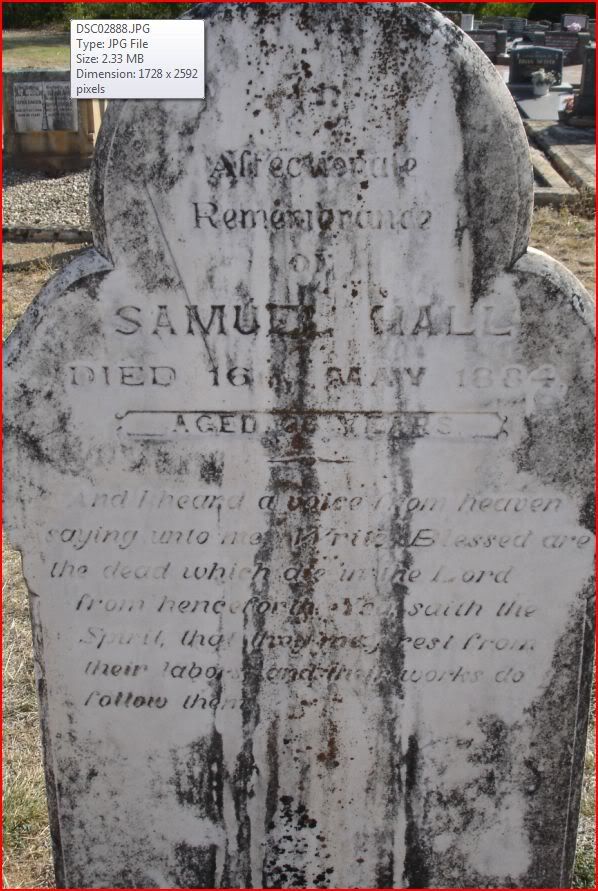------------------
Samuel HALL was born in or near Fenstanton, Huntingdonshire, England in 1816, the son of William HALL, a shoemaker, and Catherine nee SETCHELL. He was baptised in the nearby Hemingford Grey (probably Catherine's home village) on the 4th September 1816, their abode being entered as Fenstanton.

On October 13 1839 Samuel married Mary Ann WELLS in the parish of Chesterton, a village 2 miles to the north of Cambridge University. Mary Ann was born in the village if Isleham Cambridgeshire to Richard WELLS (a labourer) and Mary nee NORMAN, in 1813 and baptised at the General Baptist church there on 10th Aug 1813. Both Samuel and Mary Ann had not previously been married, and Samuel's sister Sarah was one of two witnesses. At least two of Samuel's sisters moved to Cambridge fom Fenstanton, though there are no records to indicate when the siblings moved there.

The 1841 England census shows Samuel, a brewers labourer, and Maryan (sic) living on Back Street in the parish of Chesterton. With them was their daughter Catharine aged 4 months - she had been baptised in Chesterton, Cambridge on 28 Feb 1841. In 1851 Samuel (listed as 'Jas'/James and a Brewers Labourer) and family are shown living at 54 Newmarket Rd in the nearby parish of Cambridge St Andrew the Less (also known at Barnwell). Cambridge St Andrew the Less seems to by no means have been a salubrious location, and was regarded in the Cambridge Chronicle as "the focus of villainy, the refuge of the common thief" in an article of 1853, and a 1849 report on sanitation and water describes sanitary conditions in the parish as wretched and a disgrace to humanity.
Two sons, Thomas James (3) and Arthur Walter (10 months) both born in Cambridge are present, though Catharine, who would have been abt 10, apears to have died in the previous 10 years. The family also had a servant, Mary Hayner, aged 22 and unmarried.The 1851 census presented some difficulties, and reveals the first of several examples where Samuel uses the name James ('Jas'), however in each case all other data confirm that this census entry is the correct one. Baptisms for Thomas and Arthur have not yet been found (nor have records of Catharine's death). The eldest of Samuel and Mary Ann's sons was William, baptised in Chesterton in 1843, and in 1851 he is not at home, but a Visitor at the home of Robert Moore, a College Porter in the same parish of Cambridge St Andrew the Less.
The 1851 English census is the last Samuel and family appear in as they sailed from Liverpool to Australia on the 'Boanerges' in 1857 with their three sons, arriving in Sydney on the 20th October of that year (they probably travelled the more than 100 miles from Cambride to Liverpool by train). The ship had only been built the previous year and carried 472 'government immigrants' (or assisted passengers) and one stow away, Thorney Smith. This means that their passage was subsidised or paid for through one of the assisted immigration schemes that operated in New South Wales. My great uncle Frank Hall's family history states that the reasons they decided to move to Australia are unknown.
The immigration records made out on arrival in NSW reveal a great deal about the famiy at this stage, and confirms many details:
Passengers per Ship Boanerges , as Inspected by the Immigration Board, arrived on the 20th October 1857.
Hall, Samuel; Age: 40; Calling: Farm Labour; Native place and country: Fenstanton, Huntingdon; Parents Names, and, if alive, their residence: William + Catherine, mother dead, father at Fenstanton; Religious calling: C.E.; Read or write: Both; Relations in the colony: Cousin Childs, residence not known. State of bodily health: Good. Remarks: 1 pound sterling.
Hall, Mary Ann; Age: 40; Calling: Wife; Native place and country: Islham, Cambridge; Parents Names, and, if alive, their residence: Richard + Mary, dead; Religious calling: C.E.; Read or write: Read; Relations in the colony: None. State of bodily health: Good.
Hall, William; Age: 14; Calling: -; Native place and country: Chesterton, Cambridge; Parents Names, and, if alive, their residence: on board; Religious calling: C.E.; Read or write: Both; State of bodily health: Good.
Hall, Thomas; Age: 11; Calling: -; Native place and country: Barnwell, Cambridge; Parents Names, and, if alive, their residence: on board; Religious calling: C.E.; Read or write: Read; State of bodily health: Good.
Hall, Arthur; Age: 7; Calling: -; Native place and country: Barnwell, Cambridge; Parents Names, and, if alive, their residence: on board; Religious calling: C.E.; Read or write: Read; State of bodily health: Good.
All members of the family were in good health, and Samuel and his son William could read and write (his younger brothers could only read) suggesting education in the Hall family. Samuel had to pay only 1 pound for their journey to Ausrtalia. One interesting piece of information was in answer to the question of relations in the colony: "Cousin Childs, residence not known". Four CHILDS brothers came to Australia, sons of Henry and Elizabeth (nee Hall) born in Hilton, three miles from Fenstanton: William, Edward, Thomas and Samuel who had all arrived by 1857, though none settled in the Yass district. While Elizabeth Childs nee Hall has not yet been shown to be Samuel's aunt, in the 1851 census in Hilton she states her town of birth as Fenstanton, but no baptism has yet been found for her - but she is three years older than Samuel's father William and likely to be his older sister. That Samuel described the Childs boys as cousins adds further weight to this.
Samuel Hall and family settled in the Yass area, 183 miles south of Sydney - they probably moved to the area because Samuel gained employment there. The Moreton Bay Courier of Saturday 21 Nov 1857 noted:
'Labor Market. LABOR MARKET.-The demand for pastoral districts is brisk; and the farmers require an extra number of hands to bring up lost time through the wet senson. The emigrants by the John Bunyan and Boanerges have been engaged at good wages. They were principally agriculturists. Mechanics have been in steady request. Female servants have been more plentiful thun any other class.'
We know that they travelled to that district fairly directly because less than three years after arriving, Mary Ann died of 'epilepsy', which apprently lasted 6 days. At the time she died the family were living at 'Bendanine' near Yass, probably the name of the large property owned by Cornelius O'Brien (still being determined). Again, in registering details of his wife's death, Samuel gave his name as 'James', and he stated that they had 3 sons living (William, Thomas and Arthur) and 2 daughters deceased, so apart from Catharine Hall they had another daughter at some point in England who also died. Mary Ann was buried on 14th May 1860 at St Clements Cemetery attached to the Angican Church in Yass. No headstone remains.
Samuel continued farming, though whether he held his own land is not yet clear. The 1871 Electoral Roll and 1872 Greville directory both state that Samuel was a farmer, living at 'Devil's Pass', Yass. By the 1878 Electoral Roll, Samuel had moved to nearby Cavan where he had a freehold property. His son William married Eliza Jane Bliss at St Clements Yass on 26 May 1868, and 17 years later Arthur marred Eliza's sister Judith/Julia in Yass on 7th Feb 1885. No marriage for Thomas has been found (his death certificate indicates he died without marrying).
Samuel, farmer, died on 16th May 1884 from 'congestion of the lungs' at 'Spring Creek' near Yass, which may have been the property name at Cavan. His son William registered the death stating Samuel's father was William Hall, boot and shoemaker and that Samuel was born in Fenstanton (all correct).

NSW Death Certificate 1884/013990
Date and place of death: 16th May 1884, Spring Creek
Name and occupation: Samuel Hall, Farmer
Sex and age: Male
Cause of death: Congestion of the lungs
Duration of last illness: 3 weeks
Medical attendant: Dr Hoeb
When he last saw deceased: 15th May 1884
Name and occupation of father: William Hall, boot and shoemaker
Name and maiden surname of mother: not known
Informant: Certified by WIlliam Hall, son, Spring Creek near Yass
Particulars of registration: 19th May 1884, Yass
When and where buried: 17th May 1884, C.E. Cemetery, Yass
Name of undertaker: R. Beverly
Name and religion of minister: Revd A.D. Faunce, C.E. Clergyman
Names of witnesses of burials: James Getman, John Lucas
Where born and how long in the Australasian colonies: Fenstanton, England, 27 years
Children of marriage:
William 40
Thomas James 36
Arthur Albert 34

Samuel was buried at the C.E. Cemetery, Yass (the cemetery at St Clement's where his wife Mary Ann was buried closed in 1868). A photo taken by Neil Grill in 2008 shows his headstone which reads:
"In affectionate remembrance of
Samuel Hall
Died 16th May 1884
Aged 69 years
And I heard a voice from heaven
saying unto me, Write, Blessed are
the dead which die in the Lord
from henceforth: Yea, saith the
Spirit, that they may rest from
their labours; and their works do
follow them."
The quote on Samuel's headstone is from Revelation 14:12. Samuel died intestate (without a Will) and as the oldest brother, William was appointed adminstrator of his fathers estate. The legal documents describe Samuel Hall as 'late of Cavan' who died with no debts. In signing their letters, William and Thomas can read and write, but Arthur appears not to be able to (he signs with his mark), and all describe themselves as farmers from Cavan near Yass. The Estate and Effects of Samuel consisted of seventy nine acres of selected land valued at nineteen pounds fifteen shillings, moneys invested amounting to eight hundred and fifty pounds and a horse saddle and bridle valued at four pounds. After paying funeral and testamentory expenses the estate was divided between the three brothers, the seventy nine acres being part of William's share. William ultimately applied to sell the land in 1891.







No comments:
Post a Comment